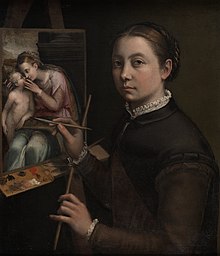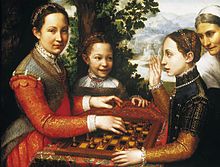Sofonisba Anguissola
Sofonisba Anguissola (c. 1532[1] – 16 November 1625) was an Italian Renaissance painter. She was also known as Sophonisba Angussola and Sophonisba Anguisciola. She was born in Cremona. Her family were nobles, but they were relatively poor. She received a well-rounded education that included the fine arts, and her apprenticeship with local painters set a precedent for women to be accepted as students of art. As a young woman, Anguissola traveled to Rome. There, she was introduced to Michelangelo, who immediately recognized her talent. She also travelled to Milan, where she painted the Duke of Alba. The Spanish queen, Elizabeth of Valois, was a keen amateur painter and in 1559 Anguissola was recruited to go to Madrid as her tutor. She had the rank of lady-in-waiting. She later became an official court painter to the king, Philip II She changed her style to the more formal requirements of official portraits for the Spanish court. After the queen's death, Philip helped arrange an aristocratic marriage for her. She moved to Sicily, and later Pisa and Genoa, where she continued to practice as a leading portrait painter.
Sofonisba Anguissola | |
|---|---|
 Self-Portrait, 1556, Lancut Museum, Poland | |
| Born | c. 1532 |
| Died | 16 November 1625 (aged 93) |
| Nationality | Italian |
| Movement | Late Renaissance |
| Patron(s) | Philip II of Spain |

The most distinctive paintings she did were portraits of herself, and her family. She painted them before moving to the Spanish court. Also, when she painted children, these looked fresh, and showed that she could observe well.
At the Spanish court she painted formal state portraits in the prevailing official style, as one of the first, and most successful, of the relatively few female court painters. Later in her life she also painted religious subjects, although many of her religious paintings have been lost. In 1625, she died at age 93 in Palermo.
Her contemporary Giorgio Vasari wrote that Anguissola "has shown greater application and better grace than any other woman of our age in her endeavors at drawing; she has thus succeeded not only in drawing, coloring and painting from nature, and copying excellently from others, but by herself has created rare and very beautiful paintings."
References
change- ↑ Great women artists. Phaidon Press. 2019. p. 35. ISBN 978-0714878775.